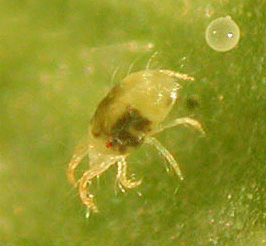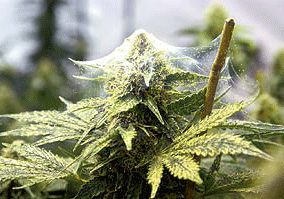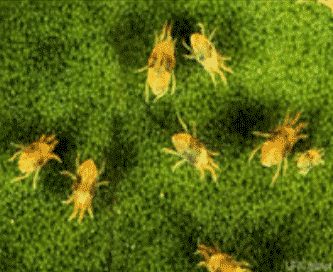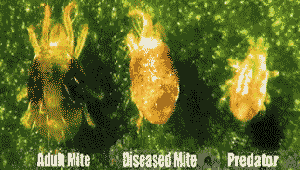Images added By Editor as they are Valuable images
 |
 |
| The Offender |
The Damage they do |
By: Advanced Nutrients
Two-spotted spider mites

Contrary to popular opinion, two-spotted spider mites (tetranychus urticae) are not insects-they are very small, almost microscopic arachnids, closely related to spiders. They suck plant juices from the leaves of your crop, causing a discolouration of leaves due to the loss of chlorophyll. Leaves of infested plants have distinct pale-yellowish blotches. The spider mite's life cycle depends on the temperature of the grow room-anywhere from 40 days at 55 degrees F or 5-7 days at 75 degrees F. As they grow from egg to larva to protonymph, deutonymph and adult, their legs increase from six to eight. As they increase in numbers, they form a very fine web on the underside of the leaves, often growing into a large web over the plant, resulting in not only the leaves dying, but eventually the plant, as well.
The absolute best way to test for spider mites at the early stage is to use a hand held magnifying glass known as an 8x film loop, which can be bought for four or five dollars. Turn the leaves over and check on the undersides. Provided there is a spider mite infestation, you should be able to see either some clear eggs, round and translucent, or some larvae or nymphs crawling around. You may also hold a clean, white sheet of paper underneath the suspected branch, and shake the plant slightly. Little specks should fall off and start crawling across the paper. If you look at them under the 8x film loop, you will confirm that the larvae have only 3 pairs of legs, while the nymphs and adults have eight legs. The adults are very small (1/60 to 1/80th of an inch, or 0.5mm in length), are oval in shape, and range in colour from clear to light yellow or green, to brownish orange. Two dark spots can be seen on the sides of the adult.
Spider mite species seem to be warm weather or cool weather active pests. The two-spotted, European red, honeylocust, and oak spider mites do best in dry, hot summer weather. The spruce and southern red spider mites do best in cool spring and fall weather.
David J. Shetlar, of Ohio State University, explains it all this way: "All spider mites go through the same stages of development. Adult females usually lay eggs on their host plants. The eggs hatch in days to weeks into the first stage, called a larva. Larvae are round bodied and have only three pairs of legs. The larvae feed for a few days, seek a sheltered spot to rest and then molt into the first nymphal stage. The first nymph now has four pairs of legs. The first nymphs feed a few days, rest and molt into the second nymph. The second nymphs feed, rest and molt into the adult stage. The males are usually the size of the second nymph and have pointed abdomens. The females have rounded abdomens and are the largest mites present."
The two-spotted spider mite is an example of a 'warm season' mite. This pest has been reported from over 180 host plants including field crops, ornamental plants, house plants and weeds. Not to forget cannabis sativa or indica or the hybrids.

Outdoors, the females over-winter in the soil or on host plants. The females become active in April and May when they seek out the undersides of leaves on suitable hosts. Each female may lay over 100 eggs. A single generation may require as much as 20 to as few as five days, depending on the temperature. These mites prefer hot, dry weather and often do not reach damaging populations in cool, rainy periods.
In the summer, the adults and nymphs are white with two greenish spots. However, over-wintering females usually turn reddish-orange and can be mistaken for other mite species.
Article Courtesy of Advanced Nutrients |